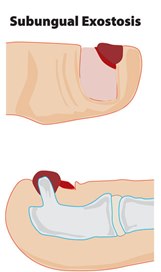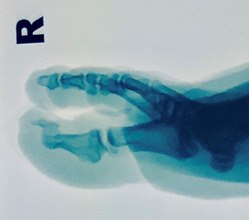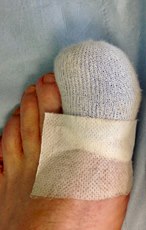Subungual Exostosis
Subungual exostosis refers to the abnormal bony projection formed on the bone present under the nail (distal phalanx). This bony projection is covered by a cartilage cap and is categorized as a benign tumor consisting of bone and cartilage.

An exostosis is a medical term referring to an abnormal bony growth on the surface of a bone.
The spur is found equally in men and women and usually presents with an onset between the ages of 30 and 50 years of age.
Diagnosis is made with a lateral x-ray of the foot that shows a pronounced bone spur on the dorsal, distal tip of the distal phalanx of the great toe.

The symptoms of a subungual bone spur include pain with direct pressure to the toe nail. A subungual bone spur is often difficult to differentiate from a chronic ingrown nail. A subungual exostosis presents with no swelling or redness and is typically diagnosed by placing direct pressure to the nail. A slight discoloration of the nail may be seen in severe cases where the nail bed has been disrupted.
The most common contributing factor to pain with a subungual exostosis is a tight toe box on the shoe. Hyperextension of the great toe at the interphalangeal joint may make the tip of the toe prone to rub against the toe box. Symptoms of a subungual exostosis may be improved or made worse by the type of shoe worn. For instance, steel toed boots would contribute to the symptoms of a subungual exostosis while an open toe sandal would improve symptoms. Conservative care of a subungual exostosis includes modification of shoes to avoid direct pressure to the toe. Padding can be used to cushion the toe.
What does surgery involve?

An incision is made along the top of the toe allowing access to the bony spur. This is freed from the surrounding bone and removed. The bone is smoothed and the skin sewn together, generally with a non-dissolvable stitch. The operation usually takes about 20-30 minutes.
You will have a bulky dressing on your foot and you will be given a post-operative boot to wear. The benefit of this procedure is that healing is usually rapid and crutches are not usually necessary afterwards. After the operation you will return to the ward, eat and start taking your painkillers. Your surgeon will then visit you to answer any questions and discharge you from hospital.
You should not drive after foot surgery and should be accompanied home by a responsible adult.
How will I feel afterwards?
Although long-acting local anaesthetic, administered during the procedure, should control most of the pain for about 8 to 10 hours, you can expect some pain or discomfort after the operation. Painkillers will be discussed with you prior to your operation and you should bring these with you on the day of surgery.
Recovering from surgery
The first 2 days
Restrict your activity to going to the toilet only. You will be able to stand and take weight on your heel. Bend your knee and ankle regularly to stimulate circulation. Most people are able to stop taking their painkillers after 48 hours. Do not leave the house, drive or get the foot wet. 2-7 days.
You should be alternately resting for approximately 20 minutes and moving around for 20 minutes. When resting, elevate your foot. Do not go out of the house, drive or get your foot wet.
At 7 days
Your foot will be checked in the outpatient clinic and your dressings will be changed. Your surgeon may advise you to increase your activity but you should still stay in your house, do not drive and keep your foot dry. Keep wearing your post-operative boot.
At 14 days
At the second post-operative appointment you will probably have the stitches taken out. This is normally painless. You will be advised to increase your activity gradually and exercise gently. You may wash and bathe normally and apply moisturising cream to the wound. You should be able to get into a wide shoe or trainer and start mobilising as pain allows. Apply regular ice packs to the foot to reduce swelling.
What are the possible risks and complications?
The successful outcome of any operation cannot be guaranteed. The following information outlines the more common complications relating to foot surgery in general and more specifically to the type of operation that you are having. General complications of foot surgery.
